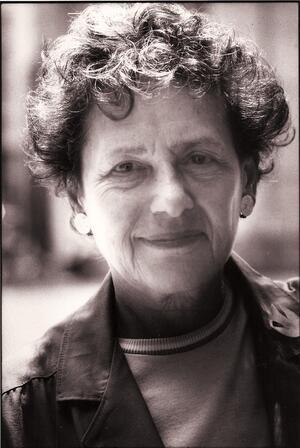Miriam Friedlander
My mother's parents emigrated around 1900 from the Jewish Pale of what is now Belarus and settled in Pittsburgh, PA. Her father David Sigel (Sigelovytch) was an office worker, insurance salesman, and political activist in the immigrant foreign language clubs. Her mother Hannah Lipman (Goldotsky) was fluent in Russian, Hebrew, Yiddish, and English. She was active in the clubs and worked as a secretary and translator.
In 1919, the family moved to New York where mom graduated from Evander Childs High School in 1931 and New York University College of Education in 1935.
Her brother Paul graduated from NYU in June 1937 with an engineering degree. He volunteered for the International Brigades in Spain and was killed fighting against the Fascists.
During her NYU years, Mom studied dance and physical education, performing in the Emily Hewlett Concert Group (dance) throughout the Metropolitan Area. She also maintained her own dance studio in the Village. In her later years, when prodded by family and friends to walk with a cane, she would reply, "I don't need one, I was a dancer and know how to fall." To the horror of onlookers, she confirmed this a number of times – without serious injury.
She painted for nearly 50 years, mostly in oils. When she could, she went to "the studio" taking weekly lessons and painting from models and still lifes. Often she would drive into the Catskills for mountain landscapes.
My parents met in 1937 at Camp Unity, a progressive resort in upstate New York. They were married in 1939, and I was born in 1943. After the war, they bought a house on the G.I. Bill in Sunnyside, Queens, and Mom became active in community organizing and the P.T.A. They were divorced in 1954.
In 1961, Mom became the Executive Director of the Citizen's Committee for Constitutional Liberties (CCCL), formed in response to the U.S. Supreme Court ruling upholding registration provisions of the McCarran Act of 1950. Along with an advisory board that included attorneys, artists, activists, clergy, scientists and politicians, they set about to reverse this vestige of the McCarthy era. They successfully lobbied for a ban on loyalty oaths in the NY State Constitution revision and exposed the continued existence of federally funded detention camps being maintained for future subversives under the McCarran Act… In the late 1960s, their work expanded to address unconstitutional surveillance and detention of anti-war activists. When Mom was elected to the New York City Council in 1973, CCCL turned out the lights in its small E. 17th street office.
Each summer in the mid-50s, the two of us would hop in the car and set out for three weeks on the road, exploring the eastern US and Canada. Once in the council, and receiving a regular paycheck, she discovered "the cruise." It opened windows on the world and provided an anonymity she relished. "What do you do?" they would ask. "Work in New York", she would reply.
After leaving the City Council in 1992, she continued traveling. She set foot on all seven continents including a zodiac wet landing in Antarctica. For each Paris, Florence, Cairo, Capetown and Sydney there were a Papua New Guinea, Tierra del Fuego, Zanzibar, Kashmir, Tashkent and Macchu Pichu. On what would now be called eco-cruises, she sailed small ships on the Amazon, Nile, Mississippi, Yenisei (Siberia), Oronoco (Venezuela), Yangtze, Volga, Rhine, Seine, Danube, Rhone and many others.
At home in her second-floor walk-up on East Sixth St., she dedicated herself to Women Fighting Poverty, an annual conference with a range of speakers and participants that ranged from prominent political figures, community activists and scholars to community members citywide. At conference end, there was always an action agenda, involving participants in issue advocacy. She also organized a series of workshops on women's' issues at the New School.
During her last years, she expressed a restrained delight at the recognition and awards bestowed upon her, the successes of those allies elected to office and the conversations with community members on the street and at her favorite bench in Tompkins Square Park.
In the end, her last words would most certainly be, "Don't Mourn, Organize!"




So many individuals, families, organizations and communities benefitted from Miriam and her championing the rights of all, but especially those who were in most need.